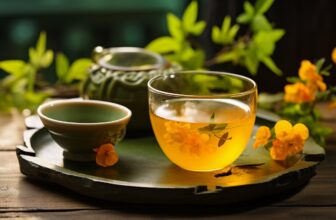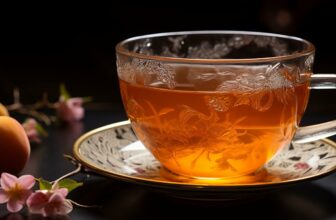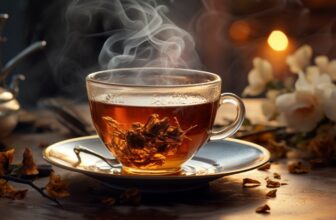
As a true tea aficionado, I am always looking for new ways to enjoy my favorite beverage. Mixing different types of tea together can create a unique flavor profile that is both enjoyable and drinkable. However, when it comes to mixing oolong and black tea, there are some considerations to keep in mind. Let’s explore the art of tea blending and how to brew the perfect cup at home.
Key Takeaways
- Blending oolong and black tea can create a unique flavor profile.
- Understanding the characteristics of true teas is essential for tea blending.
- Tea blending requires balancing flavors and experimenting with different ingredients.
- Consider factors such as brewing temperatures and steeping times when mixing oolong and black tea.
- Pro tips for blending tea include adjusting the ratio and enhancing the flavors.
Understanding True Teas and Their Characteristics
As a tea enthusiast, I find the world of true teas fascinating. Derived from the Camellia Sinensis plant, true teas come in various types, each with its unique flavor profile and characteristics. Let’s explore the different types of true teas, including black tea, green tea, oolong tea, and white tea.
| Tea Type | Flavor Profile |
|---|---|
| Black Tea | Strong and malty flavor |
| Green Tea | Grassy to nutty flavor |
| Oolong Tea | Combines characteristics of black and green tea; lighter varieties have a floral flavor, while darker varieties offer hints of burnt sugar |
| White Tea | Sweet and delicate flavor |
Black tea is known for its robust taste, while green tea is prized for its health benefits and diverse flavor range. Oolong tea, with its unique combination of black and green tea characteristics, offers a distinctive experience. The flavor of oolong tea can vary depending on the processing method, ranging from light and floral to rich and toasty. On the other hand, white tea boasts a delicate and sweet taste, thanks to minimal processing.
Understanding the flavor profiles of true teas is essential when it comes to blending them together. Each type brings its own distinct notes and characteristics to the blend, allowing for endless possibilities in creating unique tea combinations.
By exploring the flavors of black, green, oolong, and white teas, you can fully appreciate the art of tea blending and create a blend that tantalizes your taste buds.
The Art of Tea Blending
Tea blending is a fascinating and creative process that allows you to mix different types of true teas together to create a unique flavor profile. Whether you’re a tea connoisseur or simply looking to explore new taste experiences, blending teas can be a delightful adventure. By combining different teas, you can create a balance of flavors and discover new combinations that tantalize your taste buds.
When it comes to tea blending, there are various techniques you can employ to achieve the desired flavor combinations. One approach is to mix different types of true teas together, such as oolong and black tea. These two teas have distinct flavors – oolong tea is known for its floral and fruity notes, while black tea offers a robust and malty taste. By blending them, you can create a harmonious blend that combines the best of both worlds.
Tea blending is an art that involves mixing different teas to create a unique flavor profile.
When blending oolong and black tea, it’s important to find the right balance of flavors. Start with equal parts of each tea and adjust the ratio based on your personal preference. You can also experiment with adding complementary ingredients, such as spices or dried fruits, to enhance the flavor profile. The key is to strike a balance between the flavors, resulting in a well-rounded and enjoyable cup of tea.
Blending Techniques
There are several blending techniques you can use to create a harmonious blend of oolong and black tea:
- Layering: This technique involves layering different teas in a container to allow them to blend naturally over time.
- Infusion: Infusing one type of tea with the other in hot water is another way to blend the flavors.
- Grading: Grading involves blending teas of different quality grades to achieve a desired flavor.
Experimenting with different blending techniques will help you find the method that works best for you and produces the desired flavor combinations.
In conclusion, tea blending is a creative and rewarding endeavor that allows you to craft your own unique flavors. By combining different types of true teas, such as oolong and black tea, you can create a delightful blend that tantalizes your taste buds. Remember to experiment with different ratios and blending techniques to find the perfect balance of flavors. So go ahead and embark on your tea blending adventure today!
Factors to Consider When Mixing Oolong and Black Tea
When it comes to mixing oolong and black tea, there are several factors to consider in order to achieve the perfect blend. These factors include the pairing of oolong and black tea, brewing temperatures, steeping times, and flavor profiles. By understanding and paying attention to these factors, you can create a well-balanced and delicious tea blend.
Paring Oolong and Black Tea
Pairing oolong and black tea involves finding the right balance between the two flavors. Oolong tea offers a range of flavors, from floral to fruity, while black tea has a strong and malty flavor. To create a harmonious blend, experiment with different ratios of oolong to black tea. Start with equal parts of each and adjust according to your taste preferences.
Brewing Temperatures and Steeping Times
Both oolong and black tea require specific brewing temperatures and steeping times to bring out their optimal flavors. Black tea should be brewed at higher temperatures, around 200°F (93°C), for a shorter time, typically 3-5 minutes. On the other hand, oolong tea benefits from lower temperatures, around 185°F (85°C), and longer steeping times, ranging from 5-7 minutes. These temperature and time guidelines may vary depending on the specific varieties of tea, so it’s always a good idea to consult the brewing instructions provided by the tea manufacturer.
Flavor Profiles
Consider the flavor profiles of both oolong and black tea when mixing them together. Oolong tea offers a complex and layered taste, with light varieties having floral and fruity notes, and darker varieties showcasing roasted and caramelized flavors. Black tea, on the other hand, is bold and robust. When blending the two, aim for a combination that highlights the best of both flavors. Experiment with different ratios and brewing techniques until you achieve a well-balanced and enjoyable taste.
Pro Tips for Mixing Oolong and Black Tea
Blending oolong and black tea can be a delightful experience that allows you to explore new flavors and create your own unique blend. To help you achieve the perfect balance, here are some pro tips for blending oolong and black tea:
- Start with equal parts of oolong and black tea and adjust the ratio based on your personal preference. You may find that you prefer a stronger oolong flavor or a bolder black tea taste.
- Experiment with different steeping techniques to enhance the flavors of each tea. For example, you can try flash brewing, which involves quickly steeping the tea for a shorter time to bring out the fresh and vibrant flavors.
- Add complementary ingredients like dried fruits or spices to enhance the overall flavor profile of your blend. This can add a touch of sweetness or a hint of spiciness, depending on your preferences.
By following these pro tips, you can create a well-balanced and delicious blend of oolong and black tea that suits your taste preferences. Remember to be creative and have fun with your tea blending experiments!
Table: Comparing Oolong and Black Tea Ratios
| Tea Type | Oolong Tea | Black Tea |
|---|---|---|
| 1:1 Ratio | A balanced blend with equal flavors of oolong and black tea. | A well-rounded blend with a mix of oolong and black tea characteristics. |
| 2:1 Ratio (Oolong to Black Tea) | A more pronounced oolong flavor with subtle black tea undertones. | A milder black tea taste with the fragrance of oolong. |
| 1:2 Ratio (Oolong to Black Tea) | A stronger black tea presence with hints of oolong in the background. | A lighter oolong flavor with a bold black tea base. |
Experiment with different ratios to find the perfect balance that suits your taste preferences. Enjoy the process of discovering your ideal blend of oolong and black tea!
Benefits of Blending Oolong and Black Tea
Blending oolong and black tea offers a range of benefits, both in terms of flavor variety and potential health advantages. When these two teas are mixed together, the resulting blend creates a unique taste experience that combines the robustness of black tea with the floral and nuanced flavors of oolong tea. This brings a new level of complexity to your tea drinking experience, offering a delightful combination of flavors.
Not only does blending oolong and black tea provide a diverse and enjoyable taste profile, but it also brings together the health benefits of both teas. Both oolong and black tea are rich in antioxidants, which help combat free radicals in the body and support overall well-being. Antioxidants have been linked to various health benefits including improved heart health, increased metabolism, and enhanced immune function.
Additionally, the combination of oolong and black tea provides a variety of flavors that can cater to different taste preferences. The blend can be customized by adjusting the ratio of the teas to achieve the desired balance of flavors. Whether you prefer a stronger black tea flavor with subtle hints of oolong or a more balanced blend of the two, the options are endless when it comes to exploring the flavor possibilities of mixing oolong and black tea.
| Benefits of Blending Oolong and Black Tea |
|---|
| Enhanced flavor profile |
| Combined health benefits of oolong and black tea |
| Customizable taste experience |
Blending oolong and black tea not only creates a unique flavor profile but also offers a range of health benefits. Both teas are rich in antioxidants, which can help boost the immune system and promote overall health.
Conclusion
In conclusion, blending oolong and black tea is a wonderful way to enhance your tea-drinking experience. By combining the distinctive flavors of both teas, you can create a unique and personalized taste profile. Moreover, this blend offers the potential for increased antioxidant intake, promoting your overall well-being. So, why not let your taste buds explore the world of oolong and black tea blended together?
Brew the Perfect Cup of Mixed Oolong and Black Tea at Home
When it comes to brewing a delicious cup of mixed oolong and black tea, following the right techniques is essential. By paying attention to brewing temperatures, steeping times, and ratios, you can create a well-balanced blend that brings out the best flavors of both teas. Here are some steps to help you brew the perfect cup of mixed oolong and black tea at home:
Gather Your Ingredients and Equipment
Start by gathering your oolong and black tea leaves, hot water, teapot or infuser, and a timer. Use high-quality loose-leaf tea for the best flavor. Measure out equal parts of oolong and black tea based on your preference and the strength of flavor you desire.
Heat Water to the Appropriate Temperature
Oolong tea is best brewed at a lower temperature of around 185°F (85°C), while black tea requires a higher temperature of around 205°F (96°C). Boil water and let it cool for a few minutes before pouring it over the tea leaves.
Steep and Strain
Place the tea leaves in the teapot or infuser and pour the hot water over them. Let the tea steep for the recommended time, which is typically 2-3 minutes for oolong tea and 3-4 minutes for black tea. Adjust the time based on your personal taste preferences.
Once the steeping time is complete, strain the tea to remove the leaves. This will prevent oversteeping and ensure a smooth and flavorful cup of tea.
Enjoy Your Perfect Cup of Mixed Oolong and Black Tea
Now that your tea is brewed, it’s time to sit back, relax, and enjoy your cup of mixed oolong and black tea. Savor the harmonious blend of flavors and the unique characteristics of each tea. You can enjoy it hot or pour it over ice for a refreshing iced tea.
Remember, brewing tea is a personal experience, so feel free to experiment with different brewing techniques, ratios, and steeping times to find the perfect balance that suits your taste. With a little practice and creativity, you’ll become a master of brewing the perfect cup of mixed oolong and black tea at home.
Conclusion
In conclusion, blending oolong and black tea is a delightful way to explore new flavors and create a unique tea experience. By understanding the characteristics of each tea and experimenting with different ratios and brewing techniques, you can craft a delicious blend that suits your taste preferences.
Not only does mixing oolong and black tea offer an array of flavors, but it also provides a range of health benefits. Both teas are packed with antioxidants that can boost your immune system and contribute to overall well-being. Incorporating a daily cup of this blend into your routine is a simple and enjoyable way to nourish your body.
Whether you prefer a hot cup of tea to start your day or a refreshing iced beverage on a warm afternoon, the oolong and black tea blend has got you covered. So go ahead, grab your favorite tea leaves, and embark on a tea blending adventure in the comfort of your own home. Cheers to the perfect cup of oolong and black tea!
FAQ
Can you mix oolong and black tea?
Yes, oolong and black tea can be mixed together to create a unique flavor profile.
How do you brew the perfect cup of mixed oolong and black tea at home?
Start by heating water to the appropriate temperature for each tea, combine equal parts of oolong and black tea in a teapot or infuser, pour hot water over the tea leaves, let steep for the recommended time, strain the tea, and enjoy it hot or pour it over ice for a refreshing iced tea.
What are the characteristics of true teas?
True teas, such as black, green, oolong, and white tea, have distinct flavors and characteristics. Black tea is strong and malty, green tea offers health benefits and ranges in flavor from grassy to nutty, oolong combines characteristics of black and green tea with floral or burnt sugar flavors, and white tea has a sweet and delicate flavor.
How can I balance the flavors when blending oolong and black tea?
Experiment with different ratios, steeping techniques, and complementary ingredients such as dried fruits or spices to achieve a well-balanced blend.
What factors should I consider when mixing oolong and black tea?
Consider the specific brewing temperatures and steeping times for each tea to bring out their optimal flavors. Black tea should be brewed at higher temperatures for a shorter time, while green oolong tea should be brewed at lower temperatures for a longer time.
What are some pro tips for mixing oolong and black tea?
Start with equal parts of each tea and adjust the ratio based on your preference. Experiment with different steeping techniques, such as flash brewing, to bring out the unique flavors of each tea. Enhance the flavor by adding complementary ingredients like dried fruits or spices.
What are the benefits of blending oolong and black tea?
Blending oolong and black tea not only creates a unique flavor profile but also offers a range of health benefits. Both teas are rich in antioxidants, which can help boost the immune system and promote overall health. Blending the teas also provides a variety of flavors, allowing you to enjoy different taste experiences.
What are the steps to brew a perfect cup of mixed oolong and black tea at home?
Start by heating water to the appropriate temperature for each tea, combine equal parts of oolong and black tea in a teapot or infuser, pour the hot water over the tea leaves, let steep for the recommended time, strain the tea, and enjoy it hot or pour it over ice for a refreshing iced tea. Adjust the brewing parameters to suit your taste preferences.











